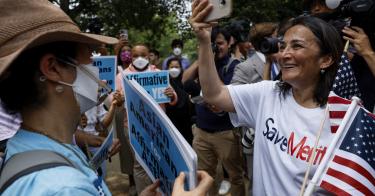In a decision that will benefit families all across the country and their high school-graduating sons and daughters who aspire to attend college, the Supreme Court has finally fulfilled its duty to uphold the guarantees of equal protection in the 14th Amendment and end the pernicious, morally repugnant racial discrimination practiced by Harvard College and the University of North Carolina (UNC), as well as many other colleges and universities.
Those contesting the decision, like President Joe Biden, are simply wrong in their unjust criticism of the Court and their continued support for allowing academic institutions to discriminate in favor of, and against, qualified students based on the color of their skin.
The critics’ claim, including the dissents written by the three liberal justices on the Court, that the Equal Protection Clause that guarantees all Americans “the equal protection of the laws” doesn’t actually mean what it says and that certain races, such as Asian Americans, can be denied equal protection defies common sense, as well as the text and history of the 14th Amendment.
In two lawsuits filed by Students for Fair Admissions against the two oldest private and public universities in the nation for discriminating against Asian American applicants, a majority of the Supreme Court, in an opinion written by Chief Justice John Roberts and joined by all of the conservative justices, concluded that the race-based admissions policies of both universities violate the Equal Protection Clause because their admissions process unlawfully incorporates an applicant’s race throughout and for many applicants, “race is a determinative” factor.
After going through an extensive history of the Court’s precedents under the 14th Amendment, including its “ignoble history” of allowing the “separate but equal doctrine” of the Plessy v. Ferguson decision in 1896 to “deface much of America,” Roberts proceeded to demolish all of the claims made by the universities to justify their discriminatory practices, stating that “[e]liminating racial discrimination means eliminating all of it.”
Roberts pointed out that the Court has permitted race-based admissions only within the confines of very narrow restrictions as outlined in its precedents, including Grutter v. Bollinger (2003) and Fisher v. University of Texas (2016). Roberts’ majority opinion concludes that none of the supposedly compelling goals proffered by Harvard and UNC to achieve “diversity” could be “subjected to meaningful judicial review.”
The benefits, said the universities, include “training future leaders,” “promoting robust exchange of ideas,” “producing new knowledge stemming from diverse outlooks,” and “preparing engaged and productive citizens and leaders.” While commendable goals, Roberts said “they are not sufficiently coherent” to meet the demands of strict scrutiny under which all policies that discriminate on the basis of race must be examined and it is unclear how courts “are supposed to measure any of these goals.” Even if they could be measured, he stated, “how is a court to know when they have been reached, and when the perilous remedy of racial preferences may cease?”
The universities also failed to show a connection between the discriminatory means they employ in admissions and their stated goal of diversity. They use racial categories to measure the racial composition of their classes that in some instances are overbroad (such as not distinguishing between South Asian or East Asian students), arbitrary or undefined (Hispanic), or underinclusive (no category for Middle Eastern students). The universities’ response to this criticism was “trust us,” but the Court held that deference to their decisions must exist within constitutional limits, and the schools have failed to justify separating students on the basis of race.
The Court held that these admissions policies fail the Equal Protection Clause’s twin commands that race may never be used as a “negative” factor and that it may not operate based on a stereotype. But the evidence showed that the colleges’ assertion that race is never a negative factor “cannot withstand scrutiny” given the decrease in the admission of Asian American students due to these policies. Moreover, the claim that the admissions policies achieve diversity of thought and viewpoint were based on the “offensive and demeaning assumption that [students] of a particular race, because of their race, think alike.”
The universities offered no “logical end point” to their racial discrimination. They argued that their use of race will end when there is meaningful representation and diversity on college campuses, based on comparing the student population to “proportional representation” in the general population, but the Court rejected this argument stating that such racial balancing is “patently unconstitutional.”
The universities also claimed they periodically review their programs to see if they are still needed, but the Court rejected that justification as well, saying that periodic review cannot make “unconstitutional conduct constitutional.” And both universities admitted that their race-based admission policies were “not set to expire any time soon – nor, indeed any time at all.”
The majority opinion concludes that:
[T]he Harvard and UNC admissions programs cannot be reconciled with the guarantees of the Equal Protection Clause. Both programs lack sufficiently focused and measurable objectives warranting the use of race, unavoidably employ race in a negative manner, involve racial stereotyping, and lack meaningful end points. We have never permitted admissions programs to work in that way, and will not do so today.
The majority opinion did add one proviso about how race can still be indirectly considered in a limited way in the admissions process, seemingly setting up what the topic will be in the future in the essays that many colleges require from students applying for admission and potentially providing a loophole that recalcitrant college administrators will try to use to get around this decision.
Universities, says Roberts, can consider an “applicant’s discussion of how race affected his or her life, be it through discrimination, inspiration, or otherwise.” However, consideration of that discussion “must be tied to that student’s courage and determination,” or “that student’s unique ability to contribute to the university.” In other words, said Roberts, “the student must be treated based on his or her experiences as an individual – not on the basis of race.”
In a scathingly accurate assessment of college administrators everywhere in the final paragraph of the majority opinion, the Court said that “universities have for too long” not treated students as individuals, but have “concluded, wrongly, that the touchstone of an individual’s identity is not challenges bested, skills built, or lessons learned but the color of their skin. Our constitutional history does not tolerate that choice.”
While there is no doubt that the leftwing media, the academic establishment, and progressive politicians will condemn this decision, the American people will not. A majority of Americans oppose racial discrimination in college admissions, which the Left likes to hide under the benign term “affirmative action,” because they inherently know it is wrong. They see no reason why their children who have worked hard, done well, and never participated in any discriminatory practices that occurred generations in the past, should be prevented from getting into a university or have the capabilities and qualifications of their children questioned and doubted in their careers because of racial preference programs.
As Roberts said in 2006 in a case involving a school board in Seattle, “The way to stop discrimination on the basis of race is to stop discriminating on the basis of race.” With today’s decision, such discrimination will hopefully finally stop being practiced in our nation’s academic institutions.
This piece originally appeared in The Daily Signal




